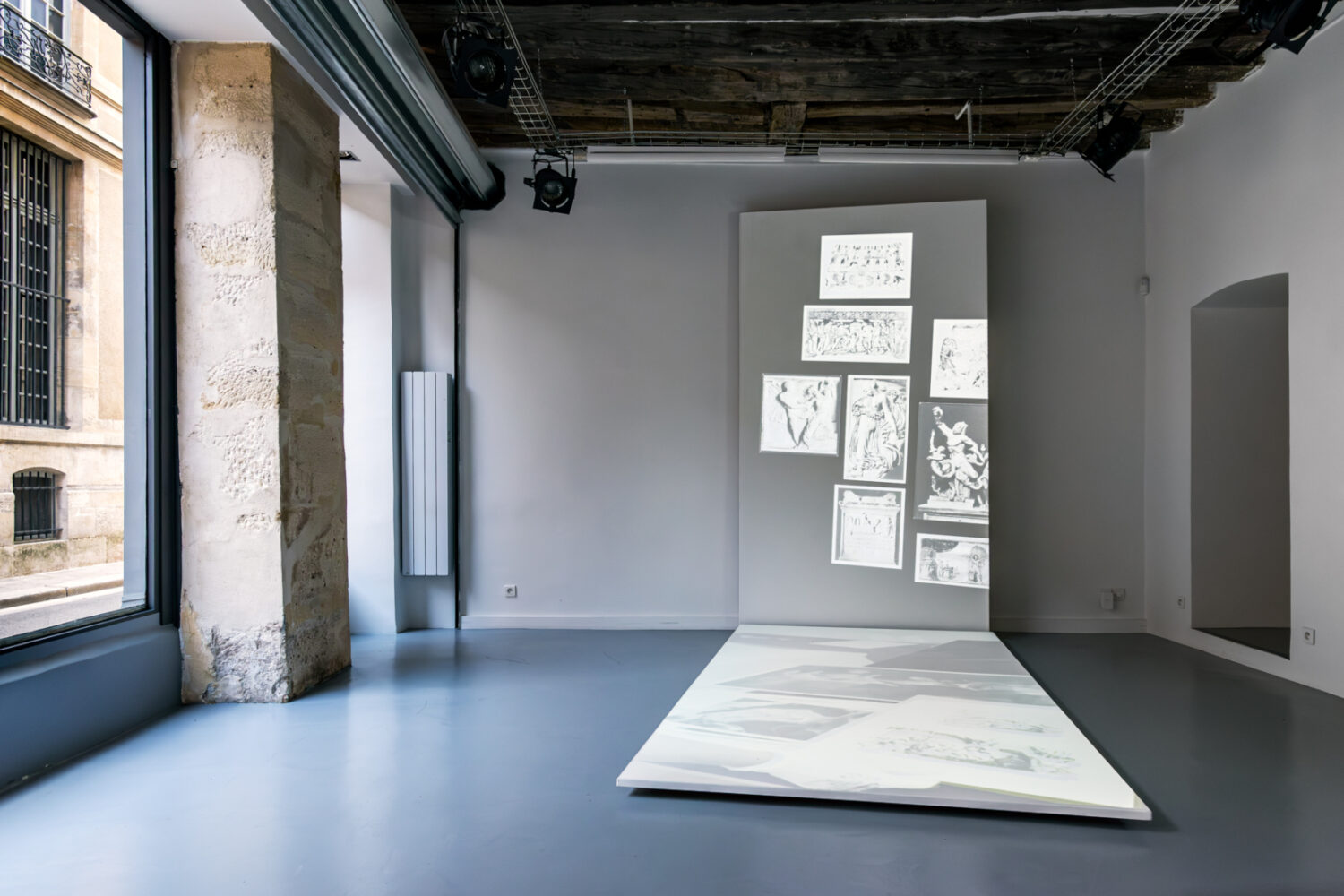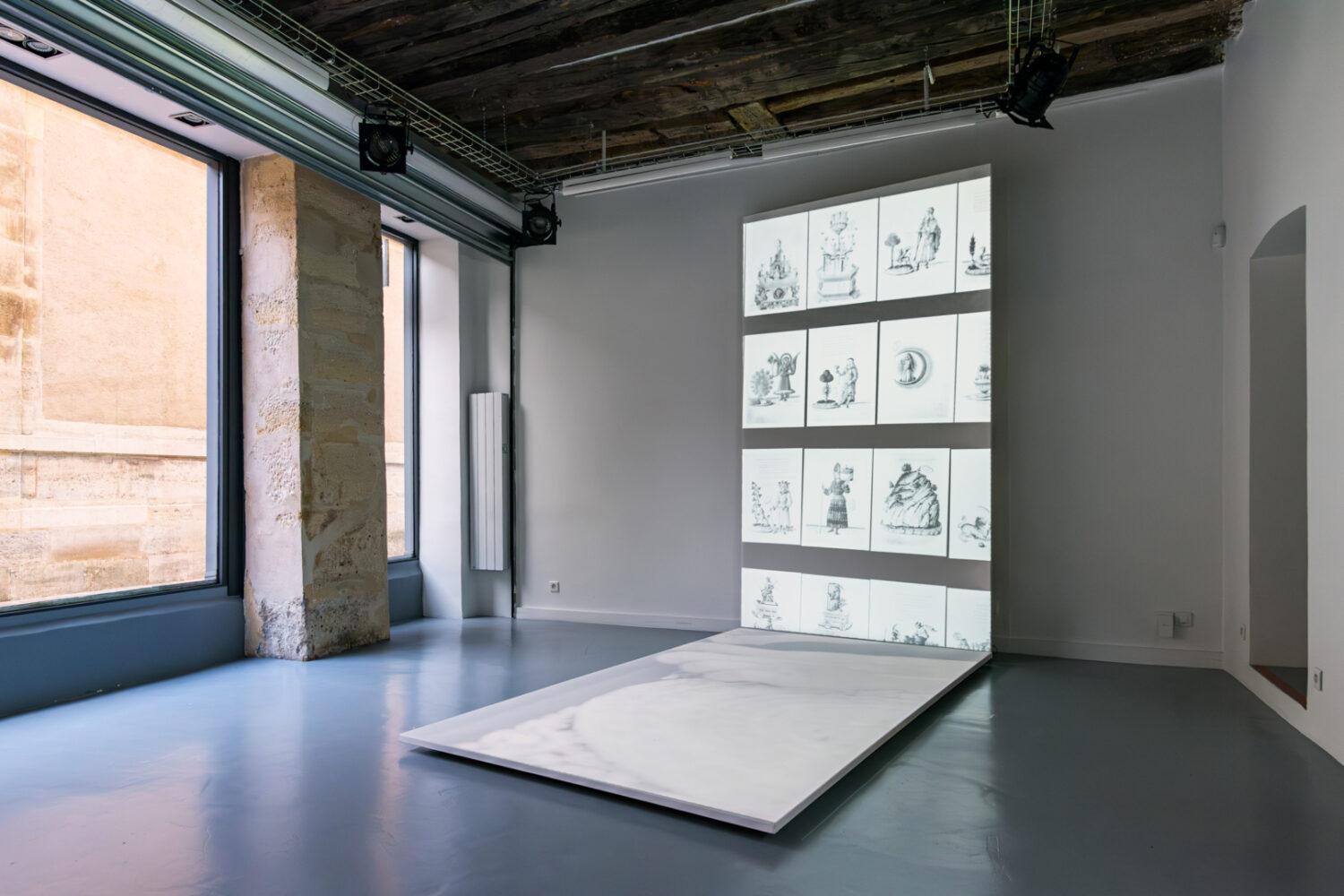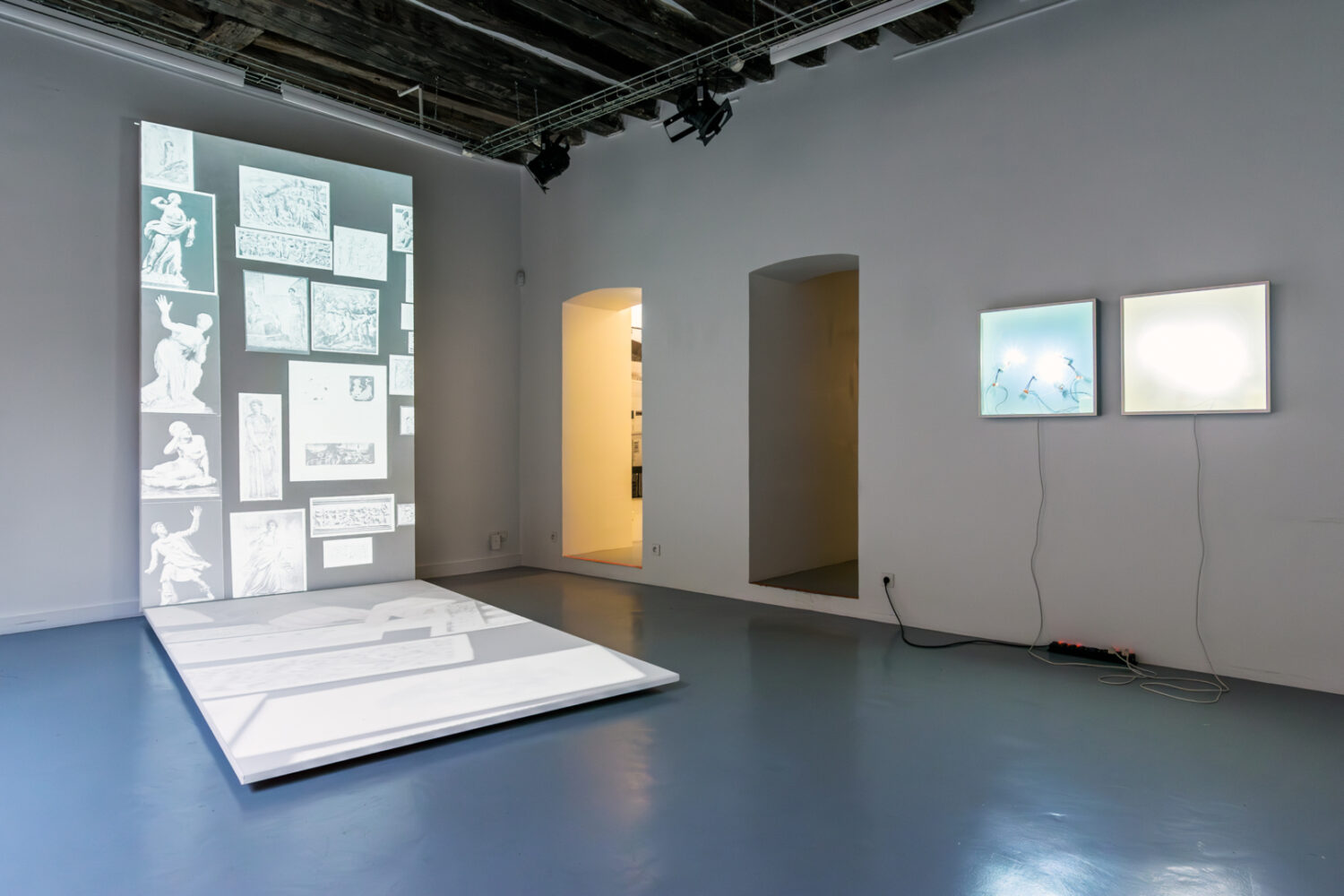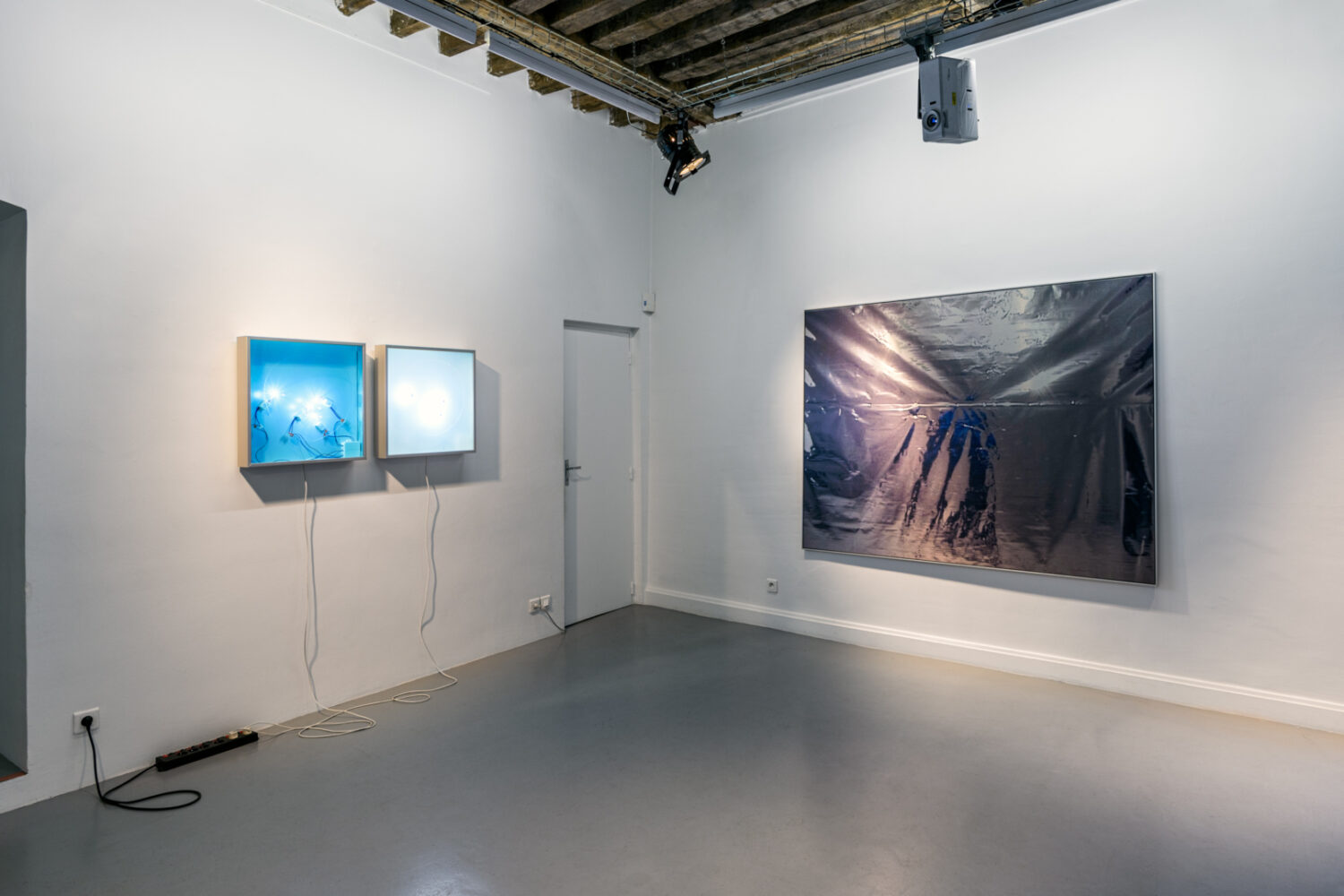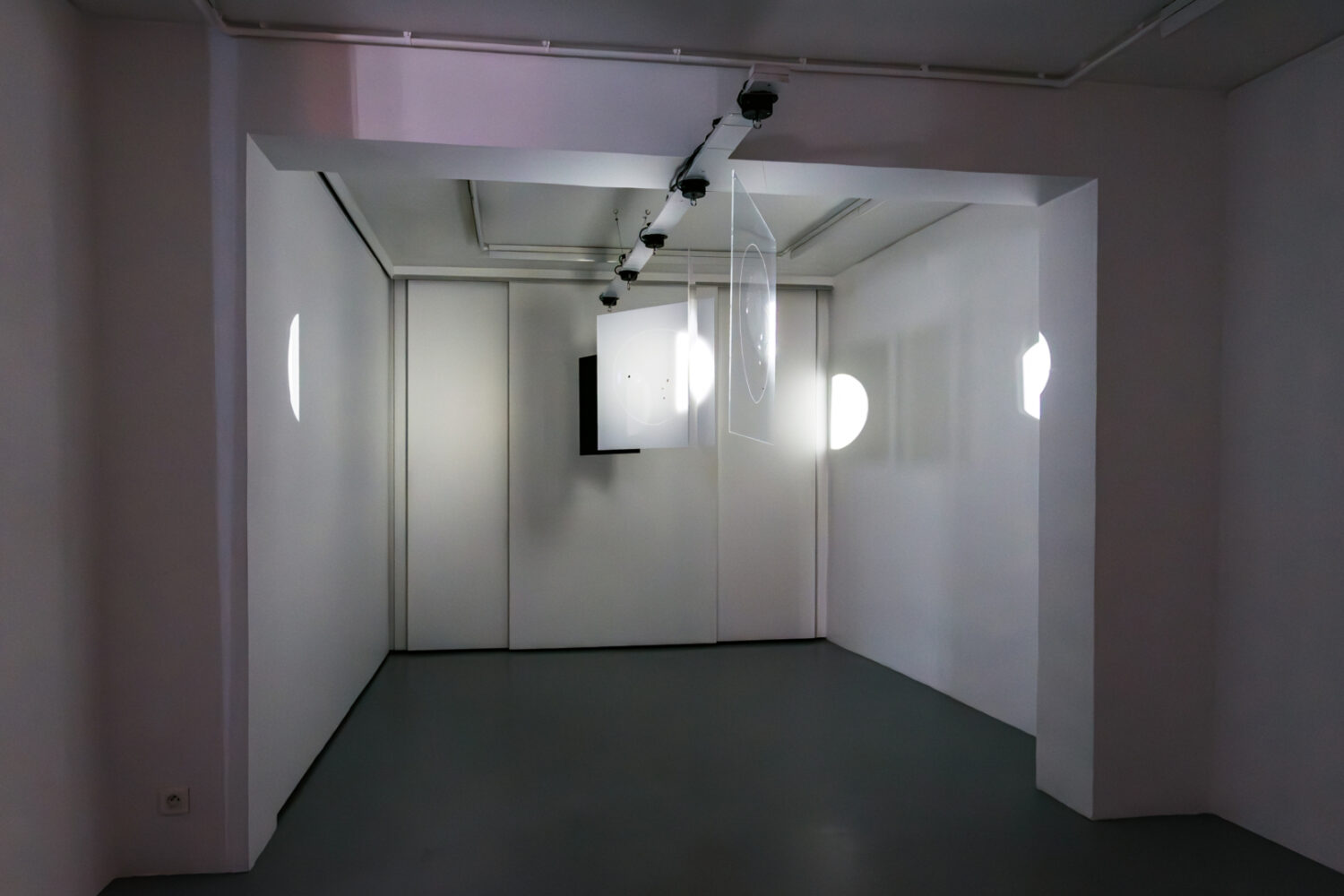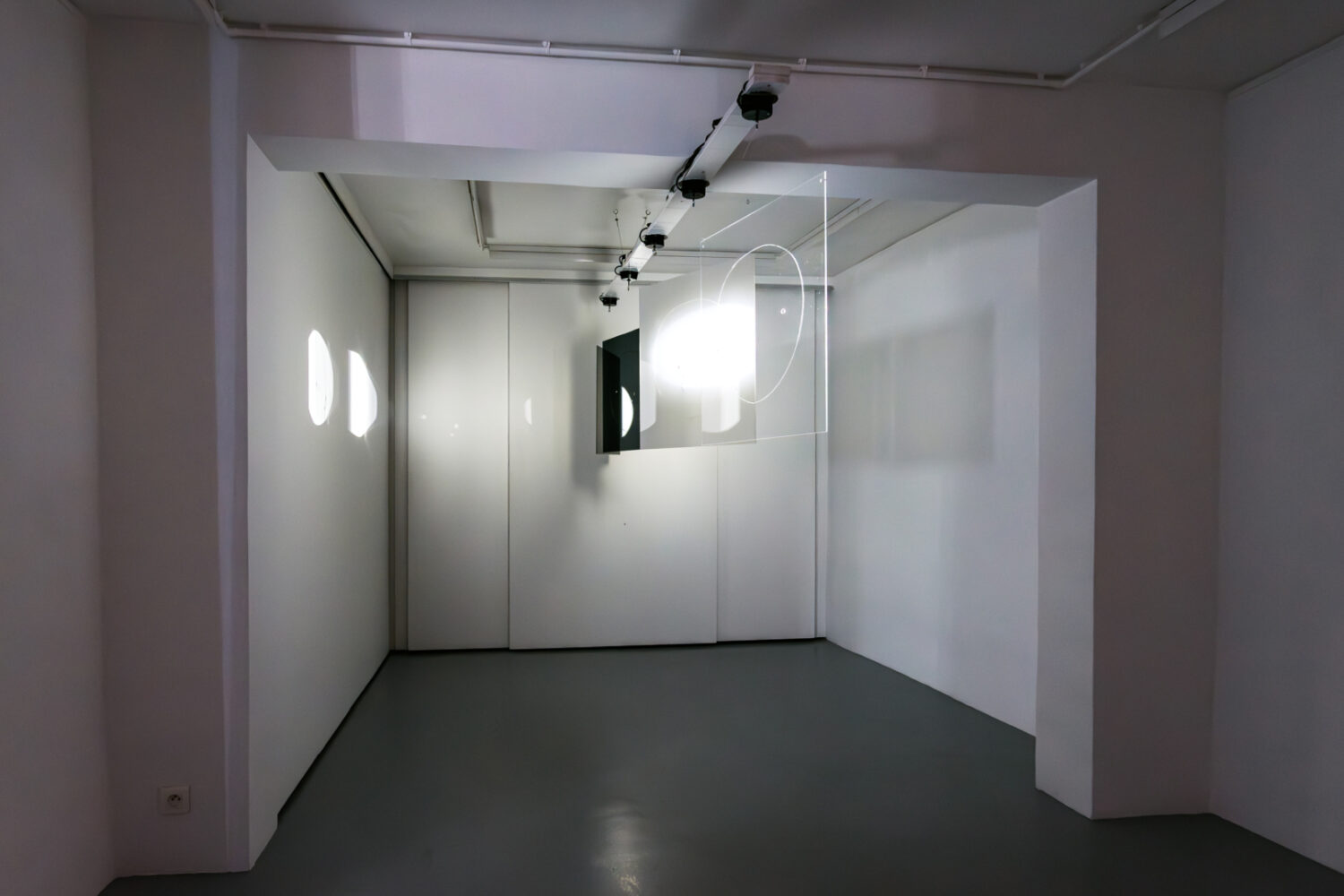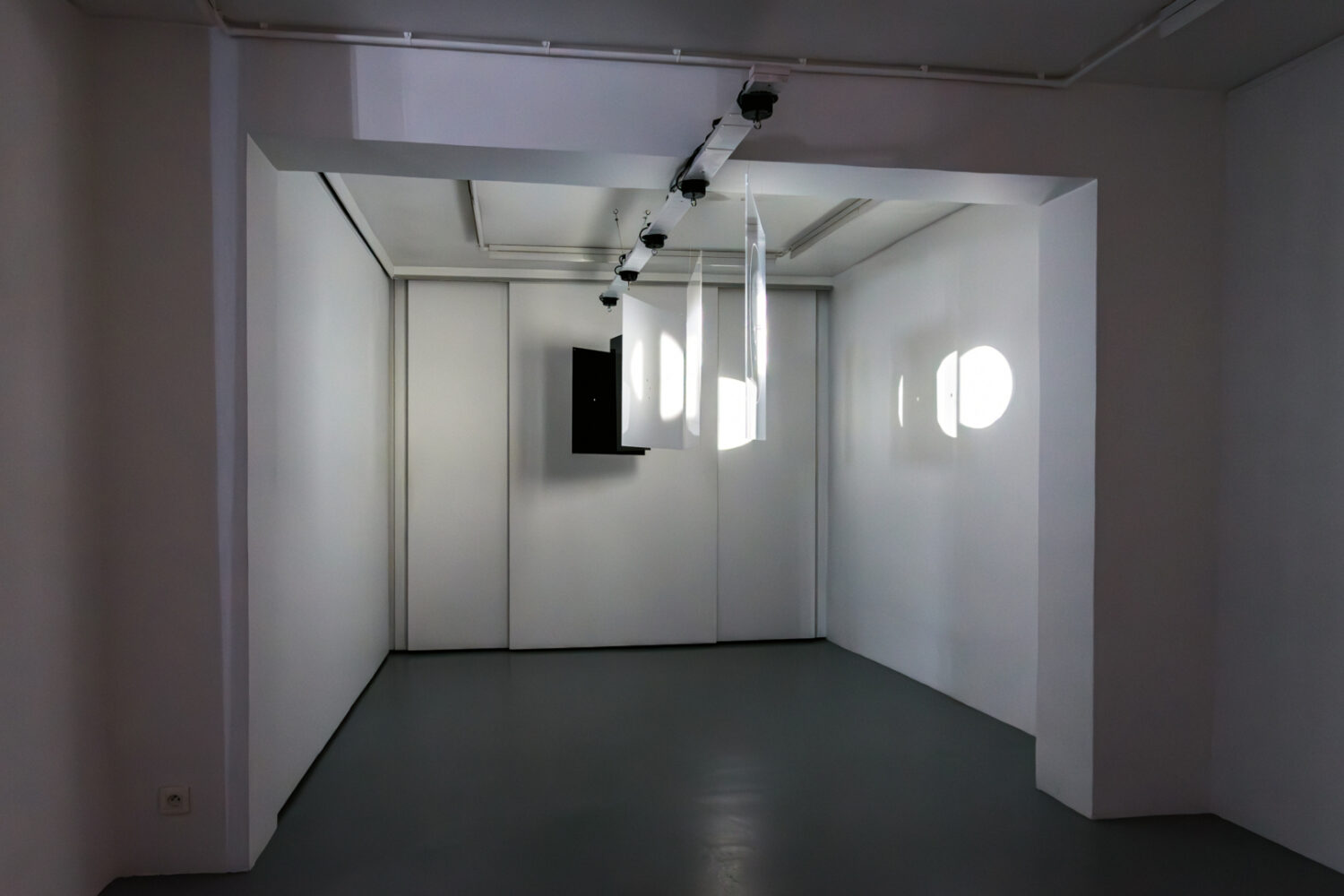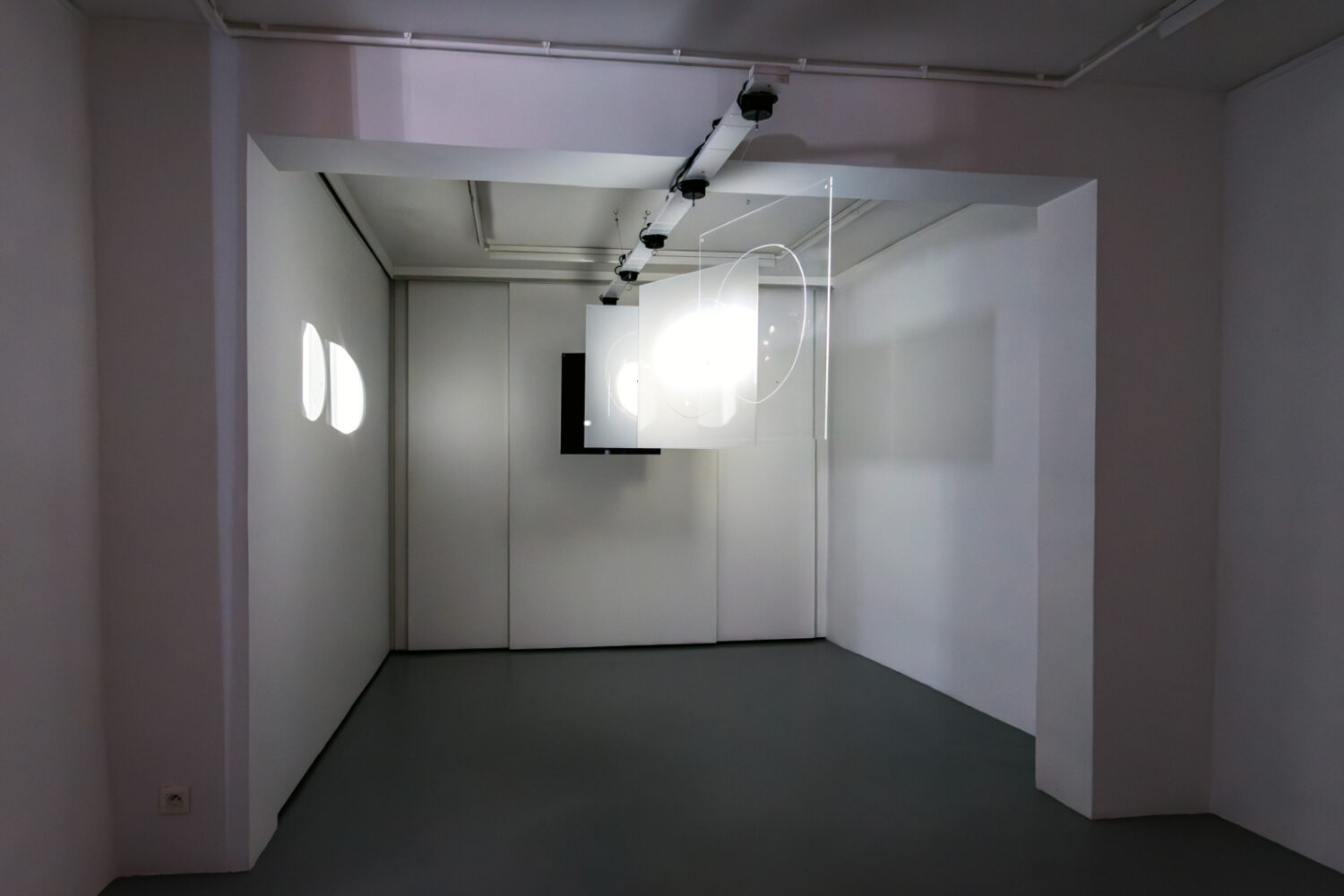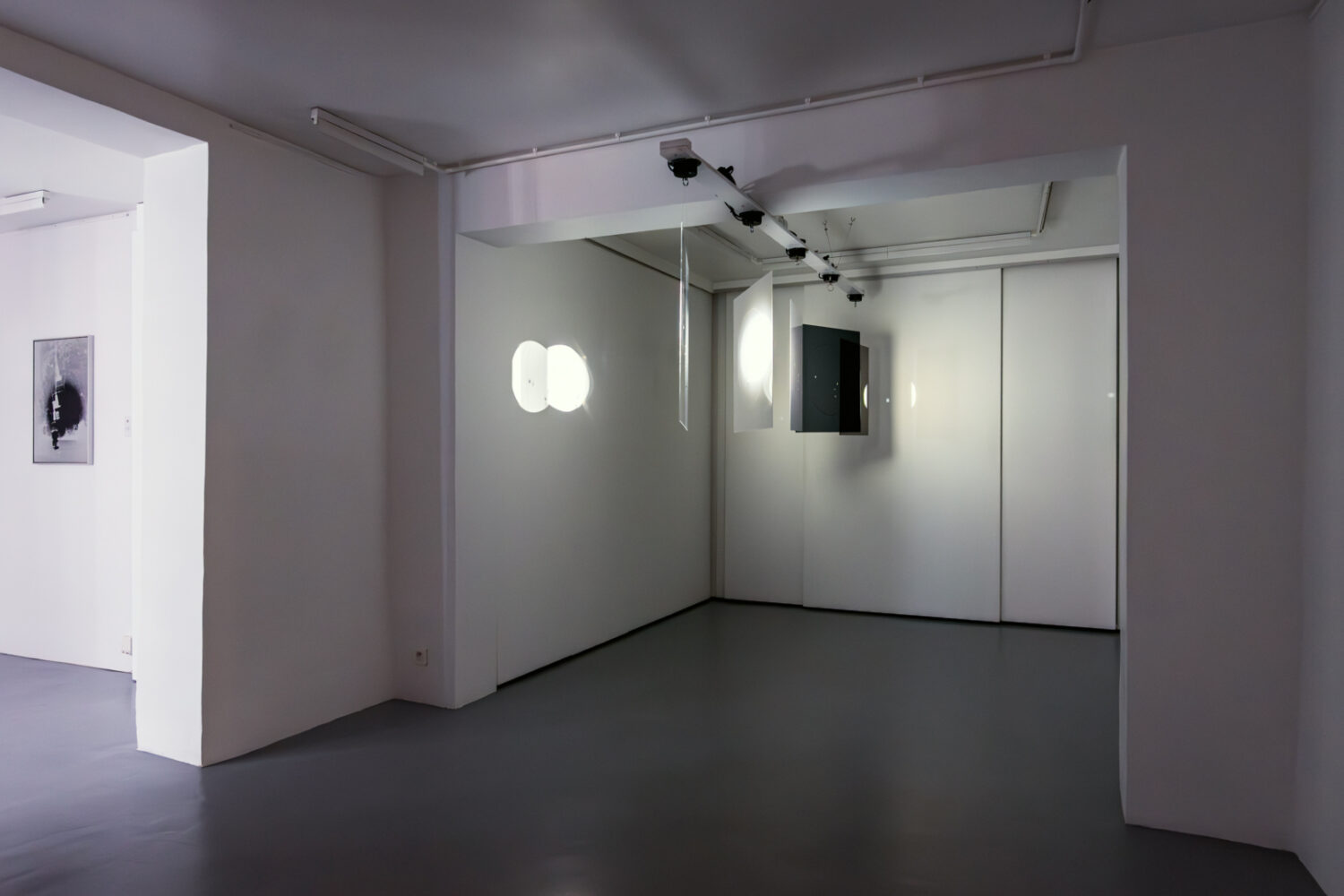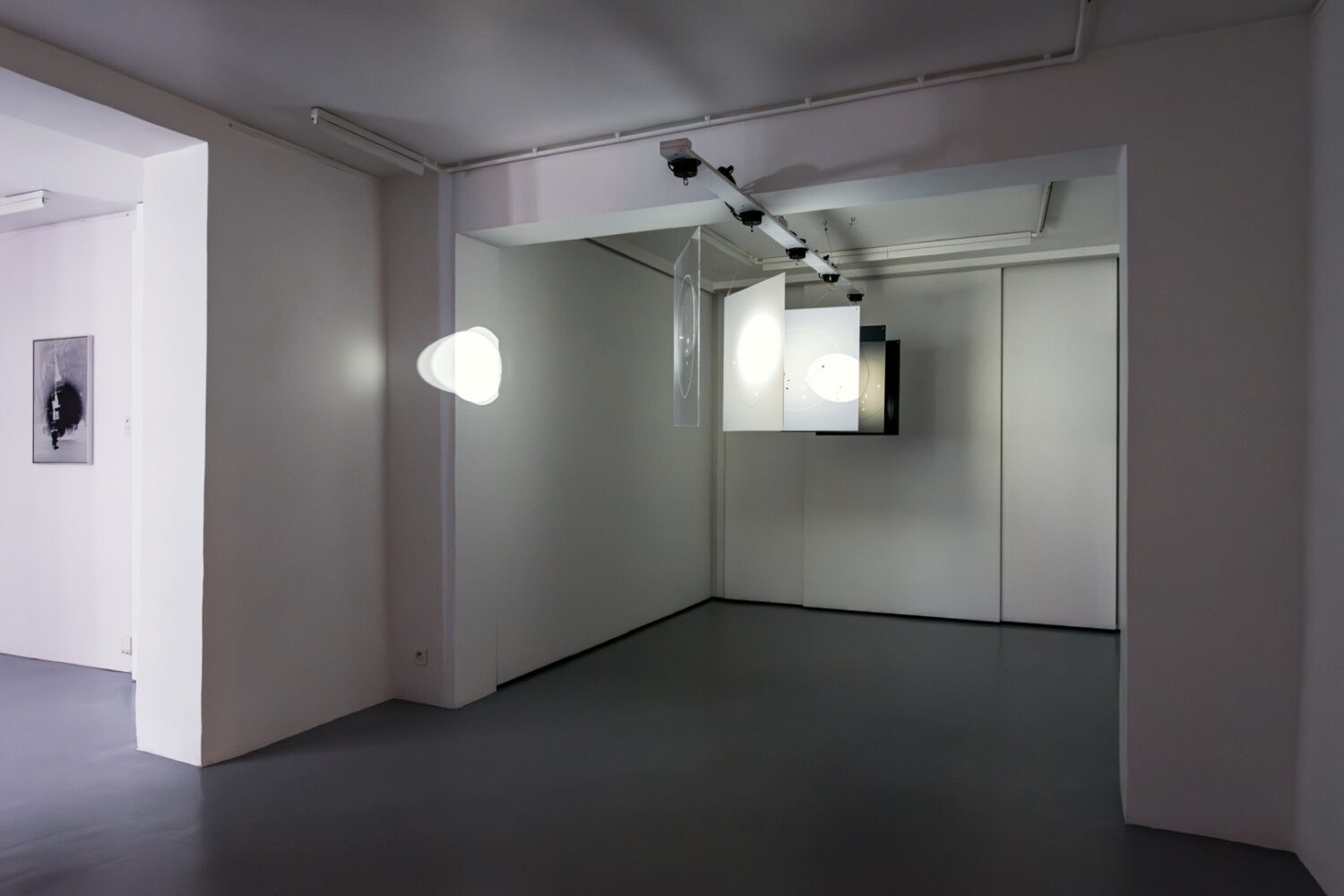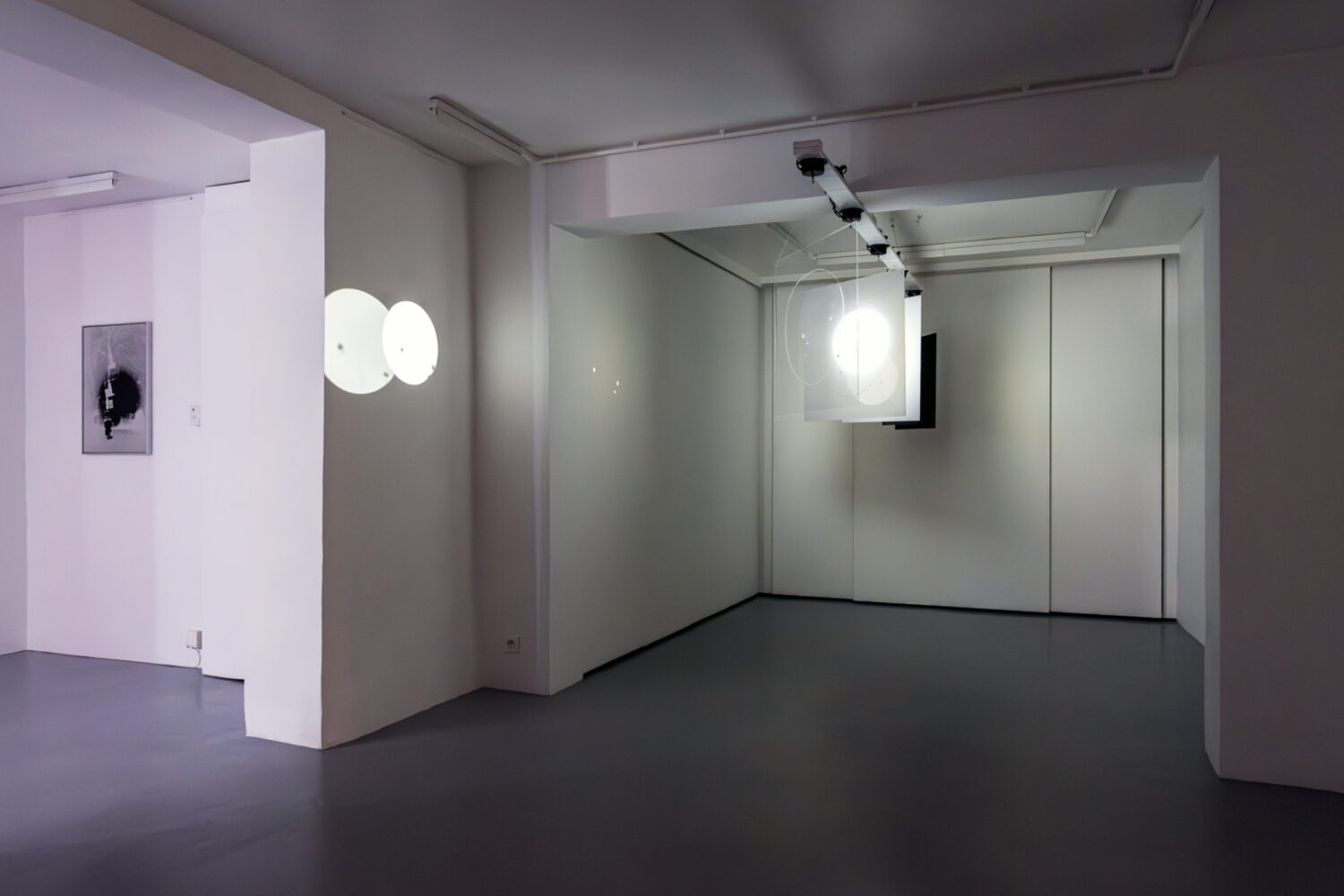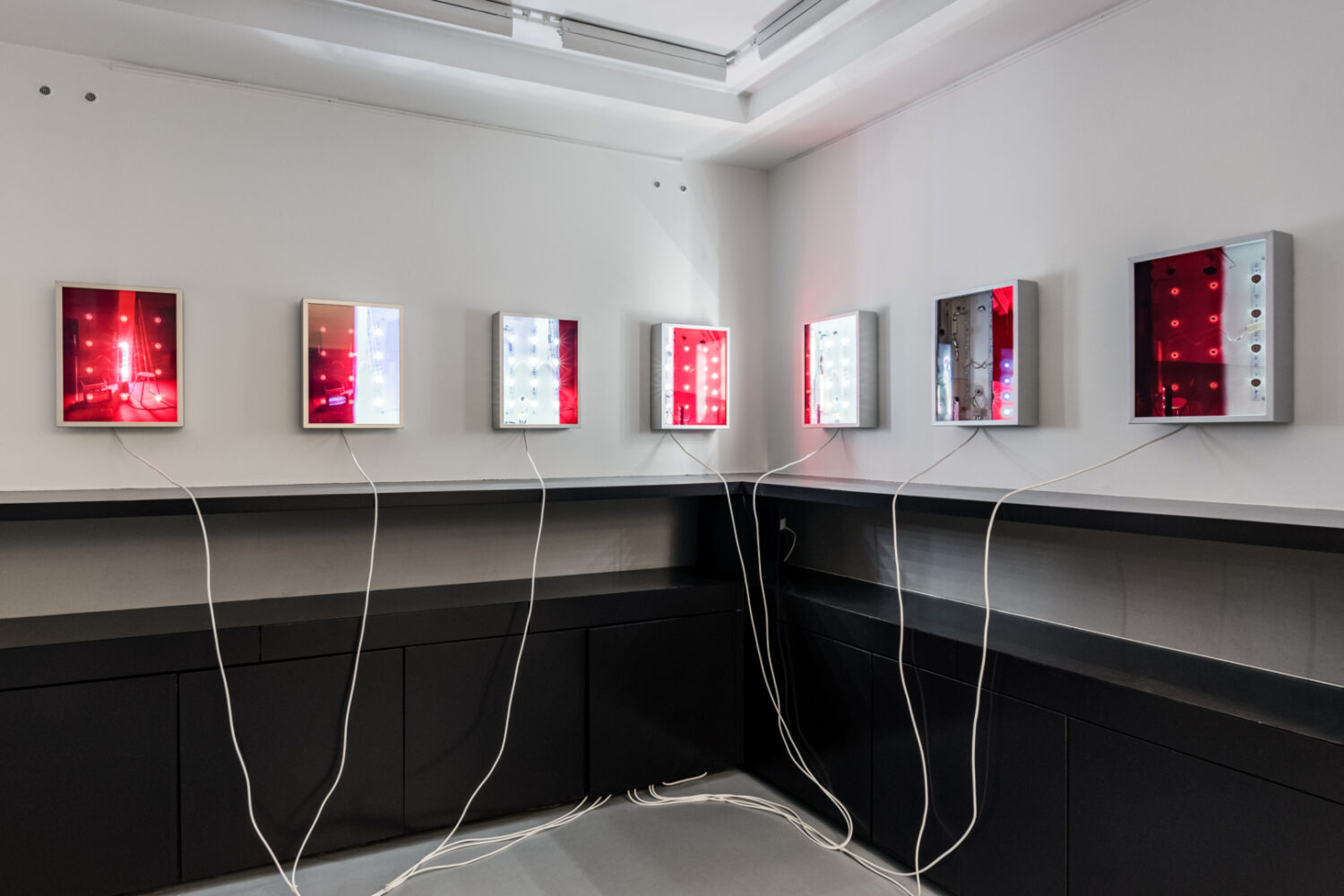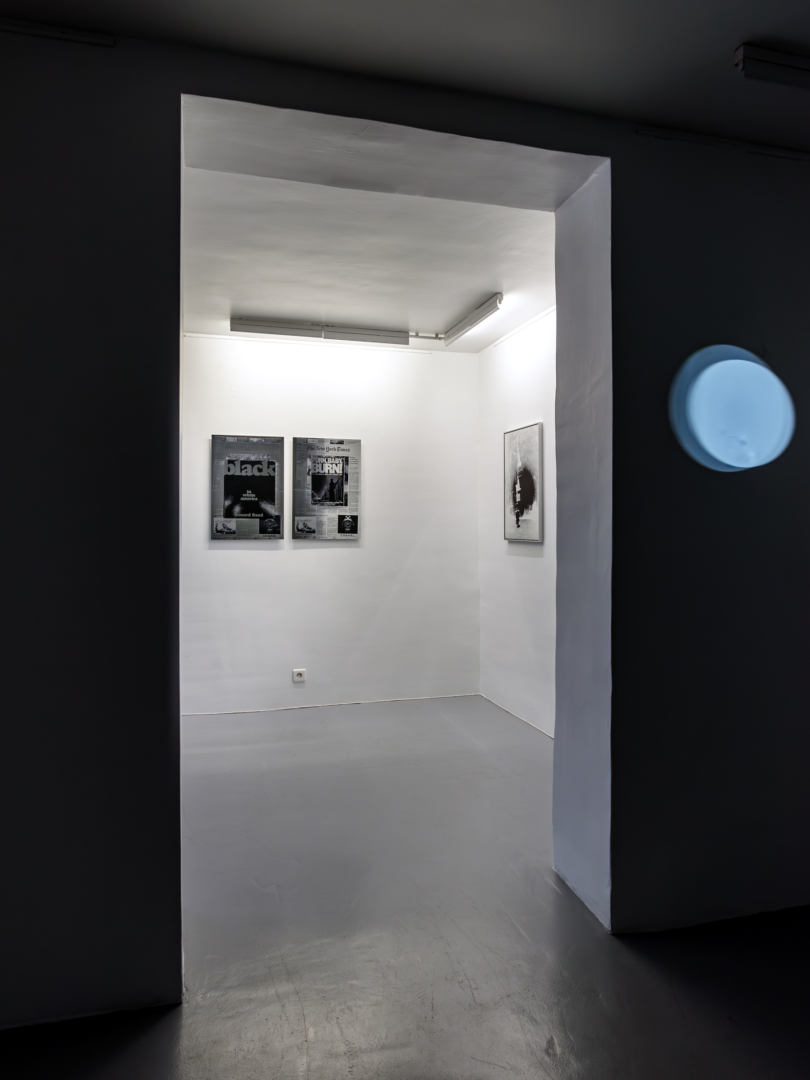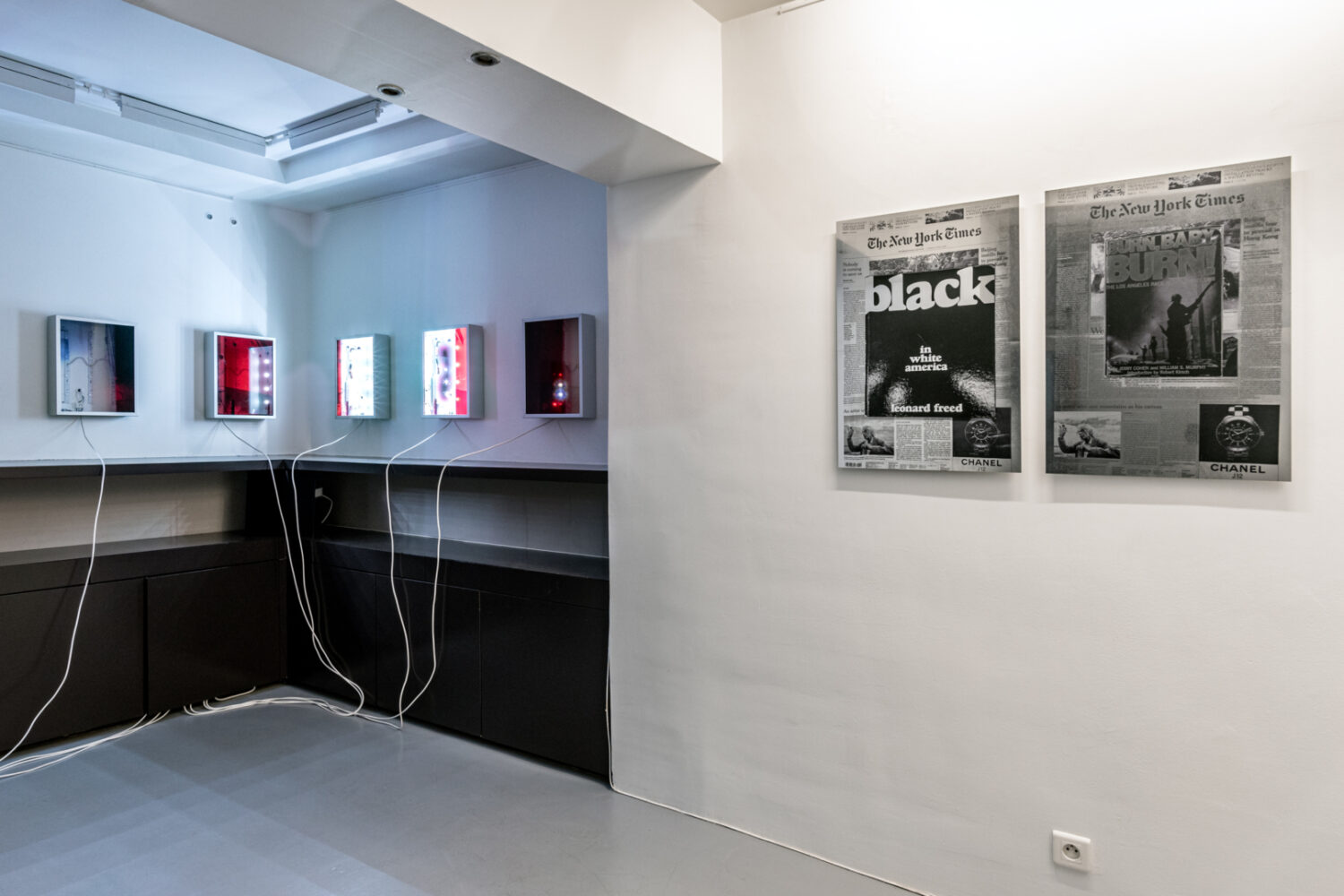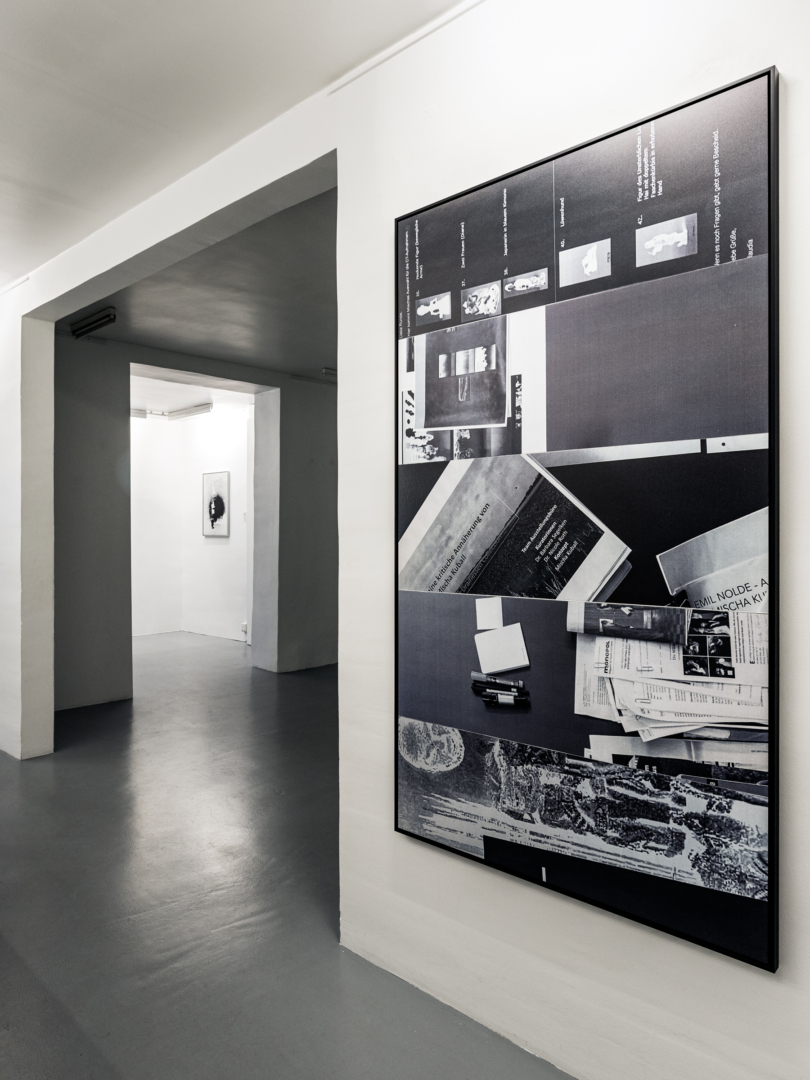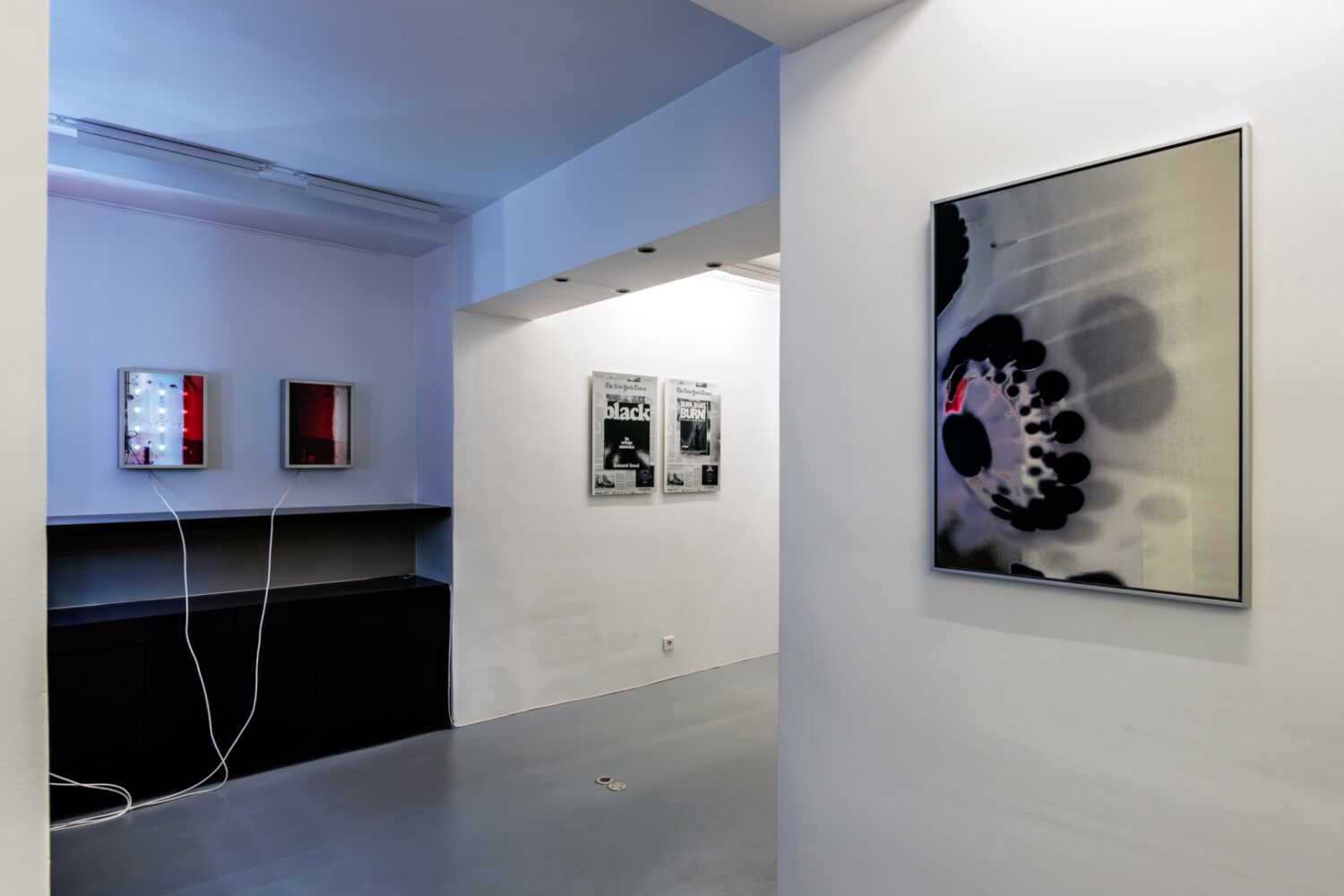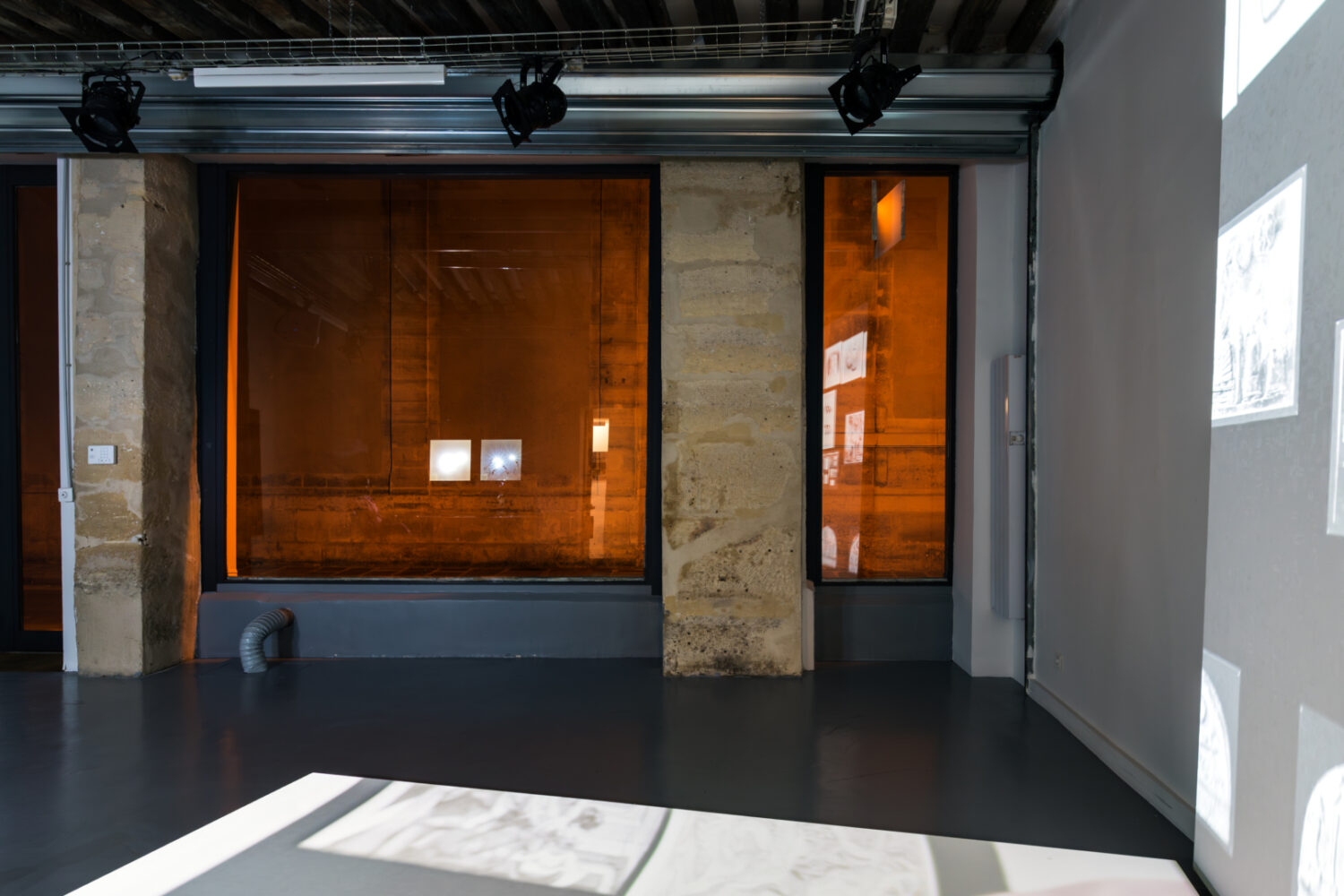PRISKA PASQUER PARIS
MISCHA – KUBALL
OPENING
13 May 2023
from 6 pm to 9 pm
14 May 2023 – 18 June 2023
PRISKA PASQUER PARIS is pleased to present ‘Eclipse and Beyond’, an individual exhibition by German conceptual artist Mischa Kuball, who was born in Düsseldorf in 1959. Kuball’s location-specific productions, performances and projections in public and institutional spaces have brought him international fame. In many cases, light is the central medium for the artist when exploring urban situations, dramaturgical control mechanisms or the interrelationship between viewers and protagonists. By directing light onto objects, people, architecture, social structures and situations, Mischa Kuball transcends discourses and common patterns of perception and reveals the invisible. But wherever there is light, there are shadows – and that is what the artist wishes to examine. Although he was presented with the German Light Art Award in 2016, it would be wrong to reduce him to this medium alone. Mischa Kuball never uses light as a means to an end but rather within a strict conceptual framework that aims to explore social, philosophical, political and scientific questions. This may be in a didactic sense as enlightenment, as an imaging technique, visualisation, communicator or as a deliberately disruptive and confusing element. The exhibition gives an overview of Mischa Kuball’s artistic work and approach, while also bringing to the fore his interest in abstract forms and their symbolic power.
Examining ‘knowledge’
Light plays a protagonist role in Mischa Kuball’s work, both in its political and perception aesthetics dimension. It does this by quite literally shining a different light on discourses or behaviour, by shifting things into focus or by putting alternative narratives centre stage. The artist is never didactic, preferring instead to induce viewers to assume new roles or perspectives and to change their position. Here, different works refer to the museum context and its function in generating academic understanding with regard to art and culture, which are conveyed as ‘knowledge’ through collections and archives. In ‘research_desk_Nolde/Kritik/Mischa Kuball’, 2020, he examines Emil Nolde (1867-1956) – the artist, the man and the myths that have grown up around him. Nolde is regarded as one of the greatest painters in the German Expressionism school. At the same time, he is one of the most ambivalent figures in art history, research in recent years having revealed him to be an anti-Semite, racist and ardent National Socialist. Mischa Kuball shines an aesthetic spotlight on Nolde’s oeuvre and shows that artists and their works are inextricably linked.
In the double projection installation ‘making of Mnemosyne (after Aby Warburg)’ in 2021, he demonstrates that Aby Warburg (1866-1929) – who is seen as one of the pioneers of modern cultural studies – had already expressed concern regarding Nolde’s image of humankind in a letter he wrote to art historian Carl Georg Heise in 1927. Through his atlas of pictures, Mnemosyne – named after the Greek goddess of memory and mother of the muses – comparative visual analysis (as an instrument for acquiring knowledge) became the essential concept underlying modern visual culture. The vertically projected video shows panels from Aby Warburg’s Mnemosyne Atlas; on the horizontal projection, we see the work on reconstructing the panels that was undertaken by the Mnemosyne research group. The physical reconstruction process is carried out by two hands. This action demonstrates that acquiring knowledge is work and that truth is never linear.
Between reproduction and reality
Another recurring theme in Mischa Kuball’s work is how reality is differentiated from the possible ways of reproducing it. In ‘platon’s mirror’ (2011), he transfers Greek philosopher Plato’s cave allegory into a light play consisting of reflections created by projecting onto silver foil. Plato distinguishes between two forms of reality: appearance and true reality. He puts these in relation to one another in an intellectual scenario – the cave allegory. In doing so, he wishes to convey that images of reality are subjective but not necessarily true. In Plato’s image of the cave, people who have been chained up there all their lives only see the shadows of objects. They do not know the real world of things that create these reflections but instead see their shadow world as being the only true reality. This is because, in order to be able to fully understand correlations, the origin needs to be known. Similarly, projected images are not tangible in Mischa Kuball’s work either because the source remains hidden. The light play is not clearly interpretable – it is merely a reflection of reality.
Insight and understanding
In the age of alternative realities, Mischa Kuball examines behaviour and context in various works, allowing us to experience that ‘reality’ can and should be called into question again and again. In the works ‘five suns / eclipse’ (2021) and ‘five suns (after galilei)’ (2018) – which refer back to a groundbreaking observation by the Italian universal scholar – Kuball reminds us to regularly change our position. Or, better still, the way we look at the world. At the beginning of the 17th century, Galilei (1564-1641) discovered, using a telescope he had built himself, dark spots on the sun disk that moved and changed. This astronomical discovery supported Nicolaus Copernicus’s view of the world, which ran counter to Church dogma: the Earth was not in fact the centre of the universe but moved around the sun. For believing in a heliocentric conception of the world, Galileo Galilei was imprisoned for heresy by the Roman inquisition and forced to recant the views he had expressed. Not only is his astronomical work seen as revolutionary today but his many drawings are also immensely impressive. Art historian Horst Bredekamp analysed these in ‘Galilei der Künstler’ (Galilei the Artist – 2007), reconstructing the scientist as an artist. This is because the images do not merely depict the new-found knowledge but the graphical representations in particular made a key contribution to Galilei’s understanding of space, light and the universe. Mischa Kuball shines his light not just on one but on five suns, with spinning discs, creating a fascinating interplay of light and shadow within the space. This leads us to understand that knowledge is not universal but depends on perspective. The exhibition title can also be read in this context. In its symbolic way, ‘Eclipse and Beyond’ casts a gloomy eye on the state of the world today while at the same time calling for a reperspectivisation.
About Mischa Kuball
b. 1959 in Düsseldorf
lives and works in Düsseldorf
Mischa Kuball, conceptual artist, has been working in the public and institutional sphere since 1977. He uses light as a medium to explore architectural spaces as well as social and political discourses and reflects on a whole variety of aspects from sociocultural structures to architectural interventions as well as emphasizing or reinterpreting their monumental nature and context in architectural history. Public and private space merge into an indistinguishable whole in politically motivated participation projects, providing a platform for communication between the audience, the artist, the work itself and public space.
Since 2007, Mischa Kuball has been Professor at the Academy of Media Arts, Cologne. Previously, he was Associate Professor for Media Art at the Karlsruhe University of Arts and Design. Since 2015 he has been a member of the North Rhine-Westphalian Academy of Sciences, Humanities and the Arts, Düsseldorf. In 2016, he was honored with the German Light Award.
Dr. Wiebke Hahn
PRISKA PASQUER PARIS freut sich mit „Eclipse and Beyond“ eine Einzelausstellung des Konzeptkünstlers Mischa Kuball (*1959 in Düsseldorf) zu präsentieren. Seine ortspezifischen Produktionen, Performances und Projektionen im öffentlichen und institutionellen Raum haben ihn international bekannt gemacht. Oft ist Licht das zentrale Medium, wenn er urbane Situationen, Mechanismen inszenatorischer Kontrolle oder das Wechselverhältnis von Betrachter*innen und Akteur*innen erforscht. Indem Mischa Kuball Licht auf Gegenstände, Personen, Architekturen, soziale Gefüge und Sachverhalte richtet, transzendiert er Diskurse und gängige Wahrnehmungsmuster und offenbart das Unsichtbare. Doch wo Licht ist, ist auch Schatten – und auch darum geht es dem Künstler. 2016 wurde er mit dem Deutschen Lichtkunstpreis ausgezeichnet. Doch es wäre falsch, ihn auf das Medium zu reduzieren. Denn Mischa Kuball setzt es nie als Mittel zum Zweck ein, sondern in einem strengen konzeptionellen Rahmen, um gesellschaftliche, soziale, philosophische, politische und (natur)wissenschaftliche Fragestellungen zu ergründen: Im didaktischen Sinne als Licht der Aufklärung, als bildgebendes Verfahren, als Visualisierung, als Kommunikator oder als bewusste Störung und Irritation. Die Ausstellung gibt einen Überblick über Mischa Kuballs künstlerische Arbeit und Herangehensweise und kehrt zudem sein Interesse an abstrakten Formen und ihrer Symbolkraft hervor.
Befragung von „Wissen“
Sowohl in seiner politischen als auch wahrnehmungsästhetischen Dimension übernimmt das Licht in Mischa Kuballs Werk eine protagonistische Funktion, indem es Diskurse oder Handlungsweisen wortwörtlich in ein anderes Licht rückt, Dinge in den Fokus bringt oder einen Bühnenraum für alternative Erzählungen schafft. Der Künstler geht dabei nie didaktisch vor, vielmehr bringt er die Betrachter*innen dazu, andere Rollen oder Sichtweisen einzunehmen und die Position zu verändern. Unterschiedliche Arbeiten nehmen dabei Bezug auf den musealen Raum und seine Funktion in der Generierung kunst- und kulturwissenschaftlicher Kenntnisse, die durch Sammlungen und Archive als „Wissen“ vermittelt werden. In „research_desk_Nolde/Kritik/Mischa Kuball“, 2020, setzt er sich mit dem Künstler und Menschen Emil Nolde (1867—1956) und seiner Mythenbildung auseinander. Nolde gilt einerseits als einer der großen Maler des deutschen Expressionismus. Andererseits ist er – aufgrund von Forschungen in den letzten Jahren, die ihn als Antisemit, Rassist und überzeugten Nationalsozialisten aufdeckten – eine der ambivalentesten Figuren in der Kunstgeschichte. Mischa Kuball unterzieht Noldes Werk einer ästhetischen Beleuchtung und zeigt, dass Künstler und Werk untrennbar miteinander verbunden sind.
In der Doppelprojektionsinstallation „making of Mnemosyne (after Aby Warburg)“, 2021, belegt er, dass Aby Warburg in einem Brief an den Kunsthistoriker Carl Georg Heise bereits 1927 das Menschenbild Noldes problematisierte. Aby Warburg (1866–1929) gilt als einer der Begründer der modernen Kulturwissenschaften. Durch seinen Bilderatlas „Mnemosyne“ – benannt nach der griechischen Göttin der Erinnerung und Mutter der Musen – wurde das vergleichende Sehen als ein Instrument der Erkenntnisgewinnung zum maßgeblichen Konzept der heutigen Bildwissenschaft. Das senkrecht projizierte Video zeigt Tafeln aus dem Mnemosyne-Atlas Aby Warburgs, auf der waagerechten Projektion wird die Arbeit an der Rekonstruktion der Bildtafeln sichtbar, die die Forschungsgruppe Mnemosyne vornimmt. Zwei Hände vollziehen den Steckprozess. In der Handlung zeigt sich: Die Aneignung von Wissen ist Arbeit und Wahrheit niemals linear.
Zwischen Reproduktion und Wirklichkeit
Ein weiteres wiederkehrendes Thema in Mischa Kuballs Arbeit ist die Differenzierung des Realen von den Möglichkeiten ihrer Reproduktion. In „platon’s mirror“, 2011, überführt er das Höhlengleichnis des griechischen Philosophen Platon in ein Lichtspiel aus Reflexionen, das durch Projektion auf Silberfolie entsteht. Platon unterscheidet zwischen zwei Formen der Realität: Schein und wahre Wirklichkeit. Diese setzt er in einem Gedankenspiel, dem Höhlengleichnis, ins Verhältnis. Damit möchte er begreifbar machen, dass Wirklichkeitsbilder subjektiv sind, aber nicht zwangsläufig wahrhaftig. In Platons Darstellung der Höhle sehen zeitlebens dort gefesselte Menschen lediglich die Schatten von Gegenständen. Die reale Dingwelt, die diese Abbilder erschaffen, kennen sie nicht. So sehen sie in der Schattenwelt das einzig wahre. Denn um Zusammenhänge vollständig verstehen zu können, muss der Ursprung bekannt sein. Auch in Mischa Kuballs Werk ist das Projizierte nicht greifbar, da die Quelle verborgen bleibt. Das Lichtspiel ist nicht eindeutig interpretierbar, es ist lediglich eine Spiegelung der Wirklichkeit.
Einsicht und Erkenntnis
Im Zeitalter alternativer Wahrheiten durchleuchtet Mischa Kuball in verschiedenen Arbeiten Handlungsweisen und Sinnzusammenhänge und macht dabei erfahrbar, dass ‘Wirklichkeit’ immer wieder hinterfragt werden kann und muss. In den Arbeiten „five suns / eclipse“, 2021, und „five suns (after galilei)“, 2018, die auf eine bahnbrechende Beobachtung des italienischen Universalgelehrten rekurrieren, erinnert er daran, regelmäßig den Standpunkt oder besser: den Blick auf die Welt zu ändern. Anfang des 17. Jahrhunderts entdeckte Galilei (1564—1641) mit einem selbstgebauten Fernrohr dunkle Flecken auf der Sonnenscheibe, die sich bewegten und veränderten. Diese astronomische Entdeckung stützte das Weltbild von Nikolaus Kopernikus, das den Dogmen der Kirche widersprach: Die Erde befindet sich nicht im Mittelpunkt des Weltalls, sondern bewegt sich um die Sonne herum. Für seinen Glauben an ein heliozentrisches Weltbild wurde Galileo Galilei von der römischen Inquisition wegen Ketzerei eingesperrt und zum Widerruf gezwungen. Heute gilt nicht nur seine astronomische Arbeit als revolutionär, zudem beeindrucken die zahlreichen Zeichnungen. Der Kunsthistoriker Horst Bredekamp hat diese in „Galilei der Künstler“ (2007) analysiert und dabei den Wissenschaftler als Künstler rekonstruiert. Denn die Bilder geben die gewonnen Erkenntnisse nicht einfach wieder, vielmehr hat insbesondere die zeichnerische Leistung maßgeblich zu Galileis Vorstellung von Raum, Licht und Kosmos beigetragen. Mischa Kuball richtet das Licht nicht auf eine, sondern auf fünf Sonnen, sich drehende Scheiben lesbar werden und ein faszinierendes Lichtspiel im Raum schaffen. Damit wird erfahrbar: Erkenntnis ist nicht universell, sondern hängt von der Perspektive ab. In diesem Kontext ist auch der Ausstellungstitel lesbar. „Eclipse and Beyond“ entwirft sinnbildlich einen düsteren Zustand der Gegenwart und ruft zugleich zu einer Neuperspektivierung auf.
Über Mischa Kuball
*1959 in Düsseldorf/DE, lebt und arbeitet in Düsseldorf/DE
Mischa Kuball, Konzeptkünstler, arbeitet seit 1977 im öffentlichen und institutionellen Raum. Mithilfe des Mediums Licht erforscht er architektonische Räume und deren soziale und politische Diskurse. Er reflektiert unterschiedliche Facetten, von kulturellen Sozialstrukturen bis hin zu architektonischen Eingriffen, die den Wahrzeichencharakter und den architekturgeschichtlichen Kontext betonen oder neu kodieren. Politisch motivierte und partizipative Projekte richten den Fokus auf die Verschränkung von öffentlichem und privatem Raum und stellen eine Plattform für die Kommunikation zwischen den Teilnehmer*innen, dem Künstler, dem Werk und dem urbanen Raum her.
Seit 2007 ist Mischa Kuball Professor für Public Art an der Kunsthochschule für Medien, Köln. Zuvor war er Professor für Medienkunst an der Hochschule für Gestaltung/ZKM, Karlsruhe. Seit 2015 ist er Mitglied der Nordrhein-Westfälischen Akademie der Wissenschaften und Künste, Düsseldorf. 2016 wurde er mit dem Deutschen Lichtkunstpreis ausgezeichnet.
Dr. Wiebke Hahn
PRISKA PASQUER PARIS a le plaisir de présenter « Eclipse and Beyond », une exposition personnelle de l’artiste conceptuel Mischa Kuball (né en 1959 à Düsseldorf). Ses créations in situ, ses performances et ses projections dans l’espace public, ou dans des lieux institutionnels, lui ont valu une renommée internationale. La lumière est le médium qu’il utilise le plus souvent pour interroger, tant les scènes urbaines, que les dispositifs scéniques de la surveillance, ou encore les interactions entre acteurs et spectateurs.
De la même façon qu’il met en lumière les gens, les objets ou les architectures, Misha Kuball éclaire les faits et les structures sociales. Transcendant les discours et les modèles de perception habituels, il donne à voir l’invisible.
Mais il n’y a pas de lumière sans ombre, et cette ombre, l’artiste, récompensé en 2016 par le Deutschen Lichtkunstpreis, s’y intéresse tout autant. On aurait tort cependant de réduire le travail de Misha Kuball à ce seul médium, qui, en aucune façon, ne constitue pour lui une fin en soi, mais bien plutôt un moyen d’explorer dans un cadre conceptuel strict, des questions sociales, sociétales, philosophiques, politiques ou encore scientifiques : au sens didactique, le travail de Mischa Kuball « éclaire » les Lumières. Il met en images, révèle, donne à voir, dans une démarche sciemment dérangeante et perturbatrice. L’exposition permet non seulement d’appréhender la démarche artistique de Mischa Kuball mais également de mettre en évidence son intérêt pour les formes abstraites et leur puissance symbolique.
Interroger le « savoir »
Que ce soit dans sa dimension politique ou perceptive, la lumière est un véritable protagoniste dans l’œuvre de Mischa Kuball. Elle met en lumière, au sens littéral du terme, les discours et les actes, met les choses en perspective et ouvre un espace scénique à des récits alternatifs. L’artiste ne procède jamais de manière didactique, mais amène plutôt le spectateur à endosser d’autres rôles, à modifier son positionnement et à envisager d’autres points de vue. Différents travaux font ainsi référence à l’espace muséal et à sa fonction dans la production de connaissances en matière d’art et de culture, lesquelles sont transmises comme « savoir » par les collections et les archives.
Dans research_desk_Nolde/Kritik/Mischa Kuball, 2020, Mischa Kuball se penche sur l’artiste et l’homme qu’était Emil Nolde (1867-1956) et sur la formation d’un mythe. Si Nolde est considéré comme l’un des grands peintres de l’expressionnisme allemand, il est aussi – à l’aune des recherches menées ces dernières années, révélant ses convictions racistes et son adhésion sans réserve au National-Socialisme – l’une des figures les plus ambivalentes de l’histoire de l’art. En soumettant l’œuvre de Nolde à un éclairage esthétique, Mischa Kuball démontre qu’on ne peut dissocier l’œuvre de l’artiste.
Dans l’installation à double projection making of Mnemosyne (after Aby Warburg), 2021, il établit qu’Aby Warburg, dans une lettre adressée à l’historien de l’art Carl Georg Heise en 1927, questionnait déjà la vision qu’avait Nolde de l’homme. Aby Warburg (1866-1929) est considéré comme l’un des fondateurs des sciences culturelles modernes. Grâce à son atlas d’images Mnémosyne – du nom de la déesse grecque de la mémoire et mère des Muses – la vision comparative, en tant qu’instrument d’acquisition des connaissances, est devenue de nos jours le concept clé des sciences de l’image. La vidéo projetée verticalement montre des planches de l’atlas Mnémosyne d’Aby Warburg, tandis que la projection horizontale montre le travail de reconstitution des planches d’images auquel procède le groupe de recherche Mnémosyne où l’on voit deux mains exécutant le processus d’emboîtement. L’action montre que l’acquisition du savoir est un processus laborieux et que la vérité n’est jamais linéaire.
Entre reproduction et réalité
Un autre thème récurrent dans le travail de Mischa Kuball est la différenciation du réel par rapport aux possibilités de sa reproduction. Dans platon’s mirror, 2011, il transpose l’allégorie de la caverne du philosophe grec Platon en un jeu de lumières fait de reflets
obtenus par projection sur une feuille d’argent. Platon distingue deux formes de réalité : l’apparence et la vraie réalité. Il les met en relation dans un jeu d’esprit, l’allégorie de la caverne. Il souhaite ainsi faire comprendre que notre perception de la réalité est subjective, et que les images ne reflètent pas nécessairement la vérité. Dans la représentation de la caverne de Platon, les hommes qui y demeurent captifs toute leur vie ne voient que des objets que leur ombre. Du monde réel ils ne connaissent que ce que leur en montrent les images. Leur seule vérité est donc celle des ombres. Comprendre pleinement ce qui relie les choses entre elles, implique d’en connaître l’origine. Ainsi, dans l’œuvre de Mischa Kuball, ce qui est projeté reste sans matérialité objective, à défaut de source identifiable. Le jeu de lumières n’est pas clairement interprétable, il n’est qu’un reflet de la réalité.
Aperçu et connaissance
À l’ère des vérités alternatives, Mischa Kuball passe au crible dans différents travaux les modes d’action et les contextes de sens, rendant ainsi perceptible le fait que la « réalité » peut, et doit, toujours être remise en question. Dans les œuvres five suns / eclipse”, 2021, et five suns (after galilei), 2018, qui se réfèrent à la découverte révolutionnaire du savant italien, il rappelle l’impératif d’un changement régulier de point de vue ou plutôt de regard sur le monde. Au début du 17e siècle, Galilée (1564-1641), découvrait, à l’aide d’une lunette astronomique de sa fabrication, des taches sombres sur le disque solaire qui se déplaçaient et changeaient d’aspect. C’est cette découverte astronomique qui a étayé la vision du monde de Nicolas Copernic, entrant en cela en contradiction avec les dogmes de l’Église : la Terre n’est pas au centre de l’univers, mais se déplace autour du Soleil. Parce qu’il croyait en une vision héliocentrique du monde, Galileo Galilei a été emprisonné par l’Inquisition romaine pour hérésie et contraint de se rétracter. Aujourd’hui, non seulement son travail astronomique est considéré comme révolutionnaire, mais on prend conscience à travers ses dessins de la portée artistique de ses travaux. L’historien de l’art Horst Bredekamp les a analysés dans Galilei der Künstler (2007), réhabilitant le scientifique en tant qu’artiste.
En effet, les images ne se contentent pas de reproduire les connaissances acquises ; on comprend à quel point la qualité d’exécution des dessins a contribué de manière décisive à la conception de Galilée des notions d’espace, de lumière et de cosmos. Mischa Kuball dirige la lumière non pas sur un, mais sur cinq soleils, qui deviennent visibles comme des disques en rotation et créent dans l’espace, un jeu de ombres et lumières fascinant. On peut ainsi mesurer à quel point la connaissance n’est pas universelle, mais est essentiellement affaire de perspective. Le titre de l’exposition prend, dans ce contexte, tout son sens. Si Eclipse and Beyond évoque de manière symbolique l’état sombre du présent, l’exposition appelle en même temps à une nouvelle mise en perspective.
Dr. Wiebke Hahn

